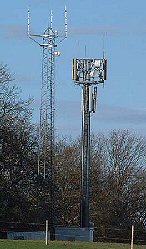


   |
Drummond Estates, Perthshire, refuses masts |
|||
|
We are concerned about the health risks, the costs, and the capacity of TETRA to provide effective police communications. |
In a laudable move giving priority to the welfare of employees, tenants, and others, Drummond Estates have refused to allow TETRA masts to be sited on their land until the health issues have been resolved. Plans for a mast in Glen Artney in south west Perthshire were spotted by concerned residents in the area and representatives of the estate were invited to a packed public meeting on the subject in Comrie. They heard talks by Ray Weldon, supported by Josh Berle and Gary Orman from Airwave, and Arthur Jarrett, spokesman on TETRA matters in Scotland for Mast Sanity, and Richard Norton of NO2TETRA, Fife. Following the talks and questions, the overwhelming consensus of the meeting was that the Scottish Executive should grant an immediate moratorium until the safety of the system has been established. The recent decision by Drummond Estates is some consolation for the community whose Council wrote a strongly worded letter to Airwave last week, on the same day that signs of construction of a TETRA mast began on a site close to homes and the primary school, and putting the whole village of 2,000 people in the high risk zone, which is considered to extend to a radius of 2km from the mast. Both the TETRA petition organised by Comrie Action on TETRA and one from Fife NO2TETRA were discussed by the Scottish Parliament Communities Committee who have received responses to requests for information from the Scottish Executive and the Association of Chief Police Officers. In addition to stories of its technological redundancy, before the Airwave infrastructure is even in place, the TETRA system has caused consternation across Britain as people have learned that its radiation contains a pulse close to the rhythms of human brainwaves, and of the implications this has for nerve function and the immune system. The Independent Expert Group on Mobile Phones, chaired by Sir William Stewart, recommended in their report to government on ‘Mobile Phones and Health’ in May 2000 that ‘as a precautionary measure, amplitude modulation around 16Hz be avoided’. TETRA pulses at 17.6Hz. The Department of Health’s acceptance of the need for a precautionary approach appears to have been merely empty rhetoric since the Home Office’s chosen £3bn system is still being rolled out, and the £5m programme of research announced in May 2003, ‘to clear up remaining areas of uncertainty’, is not due to be completed for another 15 years. Drummond Estates decision seems to be fully vindicated as reports of ill health ranging from headaches, nausea and sleep disruption where Airwave TETRA masts have been activated, to brain haemorrhages, cancers, and motor neurone disease in the vicinity of the older Dolphin TETRA masts, continue to emerge. Information supplied by Ingrid Robson, Comrie, Crieff
|
 TETRA alongside Orange in Scotland |
|
Home | |||